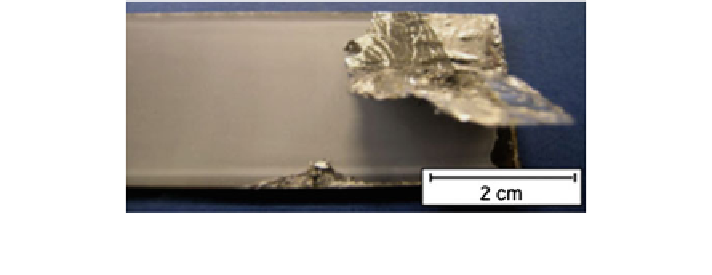Environmental Engineering Reference
In-Depth Information
Fig. 13 Steel 1.4301 coated with a silazane/h-BN, annealed at 800
°
C (for 1 h at 800
°
C) in an
aluminum melt
examples for two types of steel coated with a mixture of hexagonal BN (h-BN) and
silazane as a binder. After annealing at 600
°
C, the crack-free coating has a
thickness of about 20
m.
This type of coating not only leads to an improved protection from oxidation and
abrasion, but also the use of special
µ
fillers also allows for the generation of func-
tional properties. The ceramic
filler h-BN is well known as releasing agent to enable
the use of steel in contact with aggressive compounds such as glass or aluminum
melts. Figure
13
demonstrates that the silazane/h-BN layer protects the steel sub-
strate from the aluminum melt and acts as releasing agent. It is very easy to remove
the aluminum from the substrate surface.
Several environmental barrier coating systems based on SiOC precursors have
been developed to protect metals from oxidation and corrosion. In order to make
thick coatings, the polymeric systems have been
fillers that
expand during the polymer-to-ceramic conversion (Torrey et al.
2006
; Torrey and
Bordia
2007
; Wang et al.
2011
,
2014
). These coatings have been shown to
demonstrably improve the oxidation resistance of both Fe-based and Ni-based
superalloys. They have been developed for a broad range of energy-related appli-
cations, including protection of metallic systems in coal-fired power plants and in
waste incineration plants. For this application, a hard and chemically very resistant,
dense coating with a thickness of >50
filled with reactive
m is required, which was achieved by
development of a composite coating on the basis of a silazane as a binder, ZrO
2
as
hard and passive ceramic
µ
filler with a CTE similar to the used steel (13CrMo4), as
well as special glass
fillers as sealing agent (G
ü
nthner et al.
2011
). Since the
thermal stability of the steel is limited to 800
°
C, it was necessary to pyrolyze the
coating only at 700
°
C. At this temperature, the ceramization of the precursor is
almost
finished and the glass powders start to melt, leading to a relaxation of the
stresses caused by the shrinkage of the precursor. Additionally, a very thin silazane
layer was applied on the metal surface as a protection of the mild steel from
oxidation during the densi
cation of the thick composite layer to improve the
adhesion of the whole coating system. As a result, it was possible to manufacture a
ceramic composite coating with a thickness of more than 100
µ
m (Fig.
14
). This
coating was successfully tested in salt melts at 540
°
C and with special abrasion

Search WWH ::

Custom Search